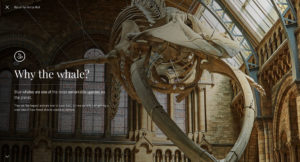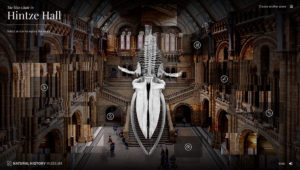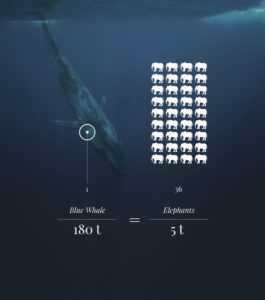 The Natural History Museum opens its doors to reveal an awe-inspiring blue whale skeleton as the star of its redeveloped central space, Hintze Hall. As part of the project, audiences are invited to discover more about the whale in both its natural and preserved environments via a new digital experience which is part of a collaboration with web development company Potato.
The Natural History Museum opens its doors to reveal an awe-inspiring blue whale skeleton as the star of its redeveloped central space, Hintze Hall. As part of the project, audiences are invited to discover more about the whale in both its natural and preserved environments via a new digital experience which is part of a collaboration with web development company Potato.
 Helping the Museum to reach new global audiences, the web app serves as a reminder that this giant of the ocean is not only a symbol of amazing biodiversity but a testament to our understanding of the natural world and our own impact on it.
Helping the Museum to reach new global audiences, the web app serves as a reminder that this giant of the ocean is not only a symbol of amazing biodiversity but a testament to our understanding of the natural world and our own impact on it.
Visitors can use the new web app to discover more about the whale itself, it’s journey from ocean to beach to museum, the innovative techniques the Museum’s team have used to learn about the stunning mammal and the importance of the whale’s new position in Hintze Hall.
Accessible via www.nhm.ac.uk/bluewhale and the NHM Visitor app for iOS and Android, the site utilises microsite generator Grow. This versatile solution allows the Museum’s team to control the site’s URLs, structure, and content easily meaning they are in full control and do not need to rely upon third parties.
 To ensure the best possible experience for users on any device, it uses a responsive image generator. As a result, a 4x retina screen gets a beautifully crisp image, whilst a user of a small mobile gets a much smaller image that won’t cause their 3g connection any problems.
To ensure the best possible experience for users on any device, it uses a responsive image generator. As a result, a 4x retina screen gets a beautifully crisp image, whilst a user of a small mobile gets a much smaller image that won’t cause their 3g connection any problems.
The site responds to user behaviour to enrich the overall experience and bring some playfulness to the app. Tailored atmospheric audio helps to immerse the user in each scene. Users will also find that as they tilt their device or move their mouse that the app’s display adjusts and provides a dynamic response.
 Potato used a lot of maths, Photoshop slices and CSS to extrude the background elements to achieve this more engaging visual experience.
Potato used a lot of maths, Photoshop slices and CSS to extrude the background elements to achieve this more engaging visual experience.
The development of the feature is reflective of the major scientific advances made by the Natural History Museum in the study and preservation of the skeleton, and the Museum’s progressive approach to digital content provision.
 Piers Jones, Chief Digital and Product Officer at the Museum, said:
Piers Jones, Chief Digital and Product Officer at the Museum, said:
“We wanted to create a highly visual experience that would work in-gallery and on mobile, so that visitors could dive deeper into the background of this fascinating specimen at their own pace. We also wanted to enable our global audience to explore elements of our blue whale’s astonishing story via our website, without compromising the experience for either viewer. Working with Potato has enabled us to meet that vision, and we look forward to exploring more opportunities to innovate in this way.”
Jason Cartwright, CEO of Potato said:
 “This digital experience means that an incredible installation is able to extend the physical gallery out into the broader world. Interactive and content-rich, it brings carefully curated information from The Natural History Museum – a leading science research centre, to a global audience.”
“This digital experience means that an incredible installation is able to extend the physical gallery out into the broader world. Interactive and content-rich, it brings carefully curated information from The Natural History Museum – a leading science research centre, to a global audience.”
The digital feature goes live alongside the opening of the new exhibition on 14 July, 2017 as part of a suite of digital interpretation materials focussing on Hintze Hall. A BBC Horizon documentary available on BBC iPlayer will go behind the scenes and explore how the team of experts tackled the enormous challenge of hanging the huge whale specimen.
Source: AKQA

You must be logged in to post a comment Login